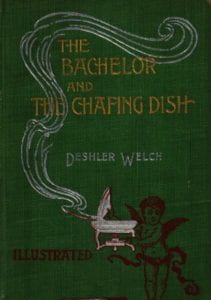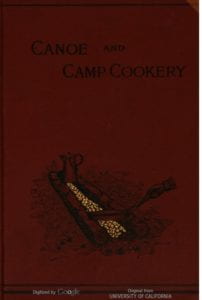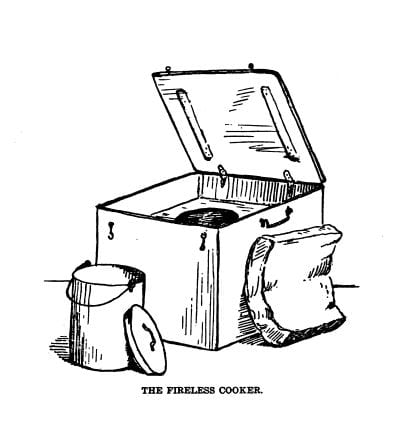The vast majority of early American cookbooks were written by and for women. Some cookbooks were written by men who were professional chefs, restauranteurs, nutritionists, doctors, military cooks, and compilers of encyclopedias of household knowledge. A very small percentage of cookbooks were written by and for men, to be used by men living without women who need or want to cook for themselves.
 The Bachelor and the Chafing Dish by Deshler Welch (New York : F. Tennyson Neely, 1896) is an interesting collection of chafing dish recipes prepared by the author “in the presence of carefully scrutinizing bon vivants on board of yachts, in private dining rooms of many clubs, in bachelor apartments, and among clever men and charming women at their homes.” The chafing dish was very popular new form of kitchen equipment in the late 19th and early 20th centuries. Chafing dish meals were simple and easy to prepare and did not require a large kitchen or the assistance of servants.
The Bachelor and the Chafing Dish by Deshler Welch (New York : F. Tennyson Neely, 1896) is an interesting collection of chafing dish recipes prepared by the author “in the presence of carefully scrutinizing bon vivants on board of yachts, in private dining rooms of many clubs, in bachelor apartments, and among clever men and charming women at their homes.” The chafing dish was very popular new form of kitchen equipment in the late 19th and early 20th centuries. Chafing dish meals were simple and easy to prepare and did not require a large kitchen or the assistance of servants.
Welch drew a sharp distinction between male and female cooks. He observed that woman often knows little cooking and “the more she may be mentally equipped to preside over the kitchen realm the less she seems inclined to have anything to do with it.” On the other hand “men appear to have an instinctive fondness for meddling with everything appertaining to the art of cookery, for such is it come to be under ingenious skill and logical deduction.”
Canoe and Camp Cookery: A Practical Cook Book for Canoeists, Corinthian Sailors and Outers by “Seneca” (New York : Forest and Stream Pub. Co., 1893) is a detailed introduction to cooking outdoors with limited equipment and ingredients. The author (actually H.H. Soule) takes issue with the majority of cookbooks which were written by “good housewives” with no knowledge of the realities of outdoor life. The book includes recipes collected from trappers and hunters as well as army and navy cooks. Detailed instructions for packing prepared foods and equipment are followed by recipes for meals made with freshly caught fish, turtles and wild game.




